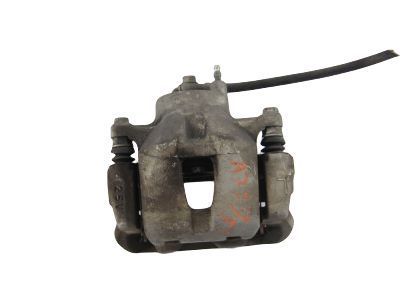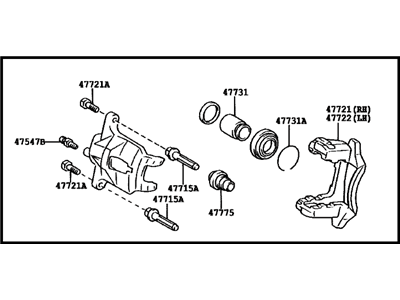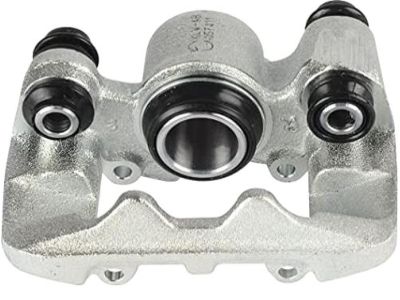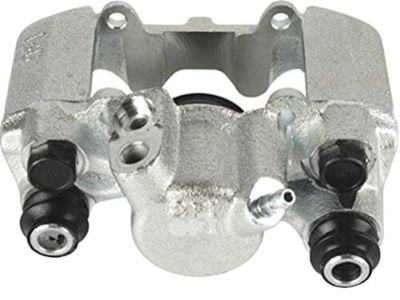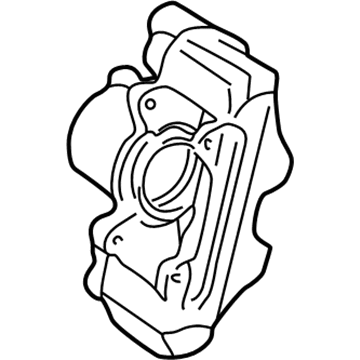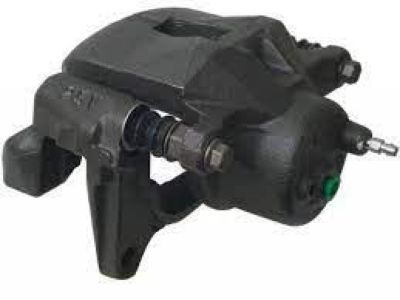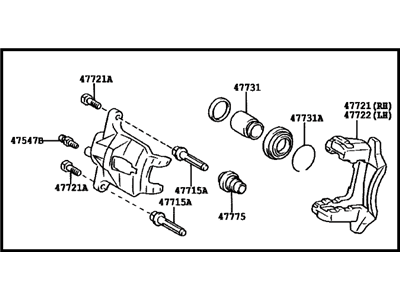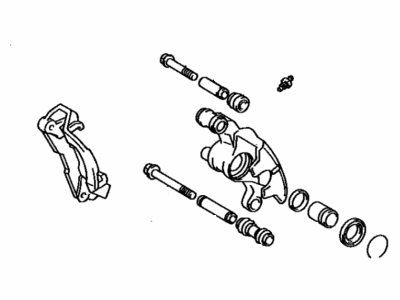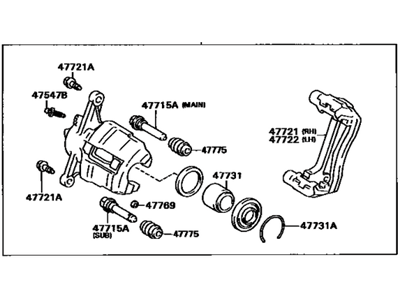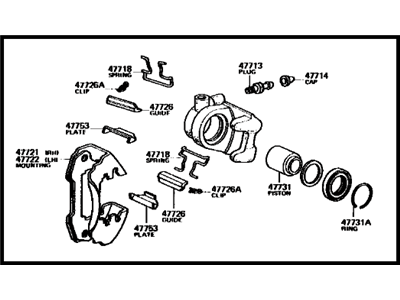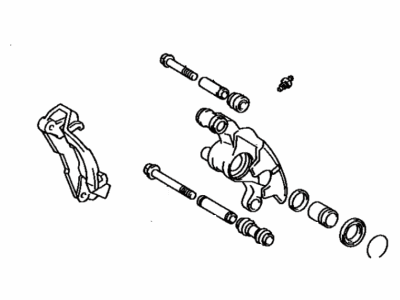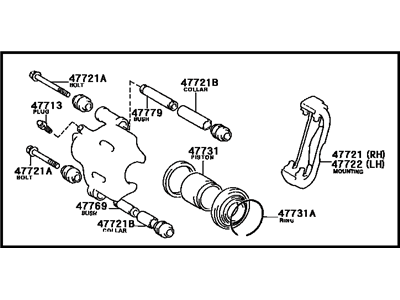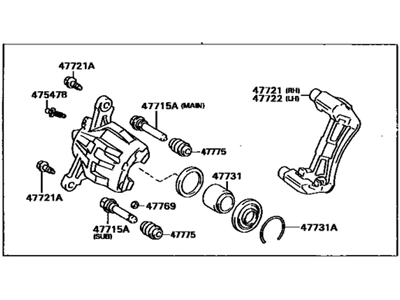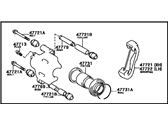

My Garage
My Account
Cart
Genuine Toyota Celica Brake Caliper
Caliper- Select Vehicle by Model
- Select Vehicle by VIN
Select Vehicle by Model
orMake
Model
Year
Select Vehicle by VIN
For the most accurate results, select vehicle by your VIN (Vehicle Identification Number).
57 Brake Calipers found
Toyota Celica Disc Brake Cylinder Assembly Left Hand
Part Number: 47750-20640$231.52 MSRP: $331.98You Save: $100.46 (31%)Ships in 1-3 Business DaysToyota Celica Rear Disc Brake Cylinder Assembly Right Hand
Part Number: 47730-20630$140.86 MSRP: $200.25You Save: $59.39 (30%)Ships in 1-3 Business DaysToyota Celica Front Disc Brake Cylinder Assembly Right Hand
Part Number: 47730-20640$231.52 MSRP: $331.98You Save: $100.46 (31%)Ships in 1-3 Business DaysToyota Celica Front Disc Brake Cylinder Assembly Right Hand
Part Number: 47730-20600$184.96 MSRP: $265.23You Save: $80.27 (31%)Ships in 1-3 Business DaysToyota Celica Disc Brake Cylinder Assembly Left Hand
Part Number: 47750-20510$184.96 MSRP: $265.23You Save: $80.27 (31%)Ships in 1-3 Business DaysToyota Celica Disc Brake Cylinder Assembly Rear Left Hand
Part Number: 47750-20620$140.86 MSRP: $200.25You Save: $59.39 (30%)Ships in 1-2 Business DaysToyota Celica Disc Brake Cylinder Assembly Rear Left Hand
Part Number: 47750-20540$232.20 MSRP: $332.95You Save: $100.75 (31%)Ships in 1-3 Business DaysToyota Celica Rear Disc Brake Cylinder Assembly Right Hand
Part Number: 47730-20260$239.53 MSRP: $343.46You Save: $103.93 (31%)Ships in 1-3 Business DaysToyota Celica Disc Brake Cylinder Assembly Left Hand
Part Number: 47750-20600$257.13 MSRP: $368.69You Save: $111.56 (31%)Ships in 1-3 Business DaysToyota Celica Front Disc Brake Cylinder Assembly Right Hand
Part Number: 47730-20610$262.26 MSRP: $376.07You Save: $113.81 (31%)Ships in 1-3 Business DaysToyota Celica Disc Brake Cylinder Assembly Left Hand
Part Number: 47750-20481$149.05 MSRP: $211.90You Save: $62.85 (30%)Ships in 1-3 Business DaysToyota Celica Disc Brake Cylinder Assembly Left Hand
Part Number: 47750-14120$237.95 MSRP: $341.21You Save: $103.26 (31%)Ships in 1-3 Business DaysToyota Celica Disc Brake Cylinder Assembly Rear Left Hand
Part Number: 47750-20260$239.53 MSRP: $343.46You Save: $103.93 (31%)Ships in 1-3 Business DaysToyota Celica Disc Brake Cylinder Assembly Left Hand
Part Number: 47750-20200$259.90 MSRP: $372.68You Save: $112.78 (31%)Ships in 1-3 Business DaysToyota Celica Front Disc Brake Cylinder Assembly Right Hand
Part Number: 47730-20210$270.99 MSRP: $388.57You Save: $117.58 (31%)Ships in 1-3 Business DaysToyota Celica Disc Brake Cylinder Assembly Left Hand
Part Number: 47750-20190$270.99 MSRP: $388.57You Save: $117.58 (31%)Ships in 1-3 Business DaysToyota Celica Front Disc Brake Cylinder Assembly Right Hand
Part Number: 47730-20200$280.65 MSRP: $402.43You Save: $121.78 (31%)Ships in 1-3 Business DaysToyota Celica Front Disc Brake Cylinder Assembly Right Hand
Part Number: 47730-20481$149.05 MSRP: $211.90You Save: $62.85 (30%)Ships in 1-3 Business DaysToyota Celica Rear Disc Brake Cylinder Assembly Right Hand
Part Number: 47730-20430$152.09 MSRP: $216.22You Save: $64.13 (30%)Ships in 1-3 Business DaysToyota Celica Rear Disc Brake Cylinder Assembly Right Hand
Part Number: 47730-33050$152.09 MSRP: $216.22You Save: $64.13 (30%)Ships in 1-3 Business Days
| Page 1 of 3 |Next >
1-20 of 57 Results
Toyota Celica Brake Caliper
If you are in demand for superior quality and affordable OEM Toyota Celica Brake Caliper, then shop with us! We own a wide range of the reduced-priced genuine Toyota Celica Brake Caliper. You can purchase in confidence as all parts come with a manufacturer's warranty. Any issues with our products? No need to worry as we have a hassle-free return policy to guide you every step of the way.
Toyota Celica Brake Caliper Parts Questions & Experts Answers
- Q: How to remove, overhaul, and install a brake caliper on Toyota Celica?A:Before taking off the wheel, first you will have to turn the lug nuts on the opposite way, and lift the car using a jack and secure it on a reliable jack stands. Loosen the bolt that connects the brake hose to the caliper and temporarily remove the brake hose and cover it since this part should not be exposed to contaminants or a lot of brake fluid. For removal of calipers, fine steps for both front and rear calipers depending on the brake pad replacement. In order to replace the caliper, remove the boot set ring, and the boot, by unscrewing; to replace the piston put a wooden block between the piston and the caliper before removing the piston. To ease out the piston, use compressed air at the brake fluid hose connection and make sure hand is not near the piston. Check the contact surfaces of the piston and the inner wall of the caliper bore for any scratches; if present replace the caliper unit. If the components of the tool are in good condition, this seal needs to be removed very gently using wooden or plastic material not to harm the tool. Sliding bushing should be pushed out from the caliper ears and dust boots should be removed from all components of the brake system and be washed in clean brake fluid or brake cleaner. When assembling, ensure that you have the right rebuild kit with you, when fitting the new piston seal and piston make sure they are soaked in brake fluid and then fit them into the caliper bore without applying any force. Crank in the new piston dust boot and set ring, lubricate the sliding bushing and sleeves with silicone based grease and fit the bushing and sleeves into the caliper ears and install the dust boot. To install the caliper back, simply do the following; To apply the caliper, reverse the aforementioned procedures: Regarding the brake hose-to-caliper connection, tighten the copper sealing washers as needed. Last of all, open the brake circuit bleeding, look for any leaks at the hose connections, and prove the brakes before putting the car back to its regular use.
Related Toyota Celica Parts
Browse by Year
2005 Brake Caliper 2004 Brake Caliper 2003 Brake Caliper 2002 Brake Caliper 2001 Brake Caliper 2000 Brake Caliper 1999 Brake Caliper 1998 Brake Caliper 1997 Brake Caliper 1996 Brake Caliper 1995 Brake Caliper 1994 Brake Caliper 1993 Brake Caliper 1992 Brake Caliper 1991 Brake Caliper 1990 Brake Caliper 1989 Brake Caliper 1988 Brake Caliper 1987 Brake Caliper 1986 Brake Caliper 1985 Brake Caliper 1984 Brake Caliper 1983 Brake Caliper 1982 Brake Caliper 1981 Brake Caliper 1980 Brake Caliper 1979 Brake Caliper 1978 Brake Caliper
